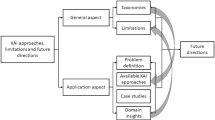Abstract
Artificial intelligence has virtually pervaded every field and its adaptation is a catalyst for organizational growth. However, the potential of artificial intelligence is often associated with a difficulty to understand the logic veiling behind its decision making. This is essentially the premise upon which XAI or eXplainable AI functions. In this field of study, researchers attempt to streamline techniques to provide an explanation for the decisions that the machines make. We endeavor to delve deeper into what explainable means and the repercussions of the lack of definition associated with the term. We intend to show in this paper that an evaluation system based solely on how easy it is to understand an explanation, without taking into account aspects such as fidelity, might produce potentially harmful explanation interfaces.
Access this chapter
Tax calculation will be finalised at checkout
Purchases are for personal use only
Similar content being viewed by others
Notes
- 1.
This goal is not explicitly listed in the original scope of XAI, but has gained traction recently with the introduction of the concept of right for an explanation in Europe’s new GDPR [10].
References
Gilpin LH, Bau D, Yuan BZ, Bajwa A, Specter M, Kagal L (2018) Explaining explanations: an overview of interpretability of machine learning. In: 2018 IEEE 5th international conference on data science and advanced analytics (DSAA), pp 80–89
Guidotti R, Monreale A, Ruggieri S, Turini F, Giannotti F, Pedreschi D (2018) A survey of methods for explaining black box models. ACM Comput Surv 51(5)
Gunning D (2017) Darpa’s explainable artificial intelligence (xai) program. In: Proceedings of the 24th international conference on intelligent user interfaces, IUI’19, page ii, New York, NY, USA. Association for Computing Machinery
Gunning D (2018) Xai for nasa
Islam MR, Ahmed MU, Barua S, Begum S (2022) A systematic review of explainable artificial intelligence in terms of different application domains and tasks. Appl Sci 12(3):1353
Kim T, Song H (2020) The effect of message framing and timing on the acceptance of artificial intelligence’s suggestion
Lipton Z (2016) The mythos of model interpretability. Commun ACM 61:10
Minsky M, Kurzweil R, Mann S (2013) The society of intelligent veillance. In: 2013 IEEE international symposium on technology and society (ISTAS): social implications of wearable computing and augmediated reality in everyday life, pp 13–17
Russell S, Norvig P (2009) Artificial intelligence: a modern approach, 3rd edn. Prentice Hall Press, USA
Selbst AD, Powles J (2017) Meaningful information and the right to explanation. Int Data Privacy Law 7(4):233–242
Author information
Authors and Affiliations
Corresponding author
Editor information
Editors and Affiliations
Rights and permissions
Copyright information
© 2023 The Author(s), under exclusive license to Springer Nature Singapore Pte Ltd.
About this paper
Cite this paper
Chahar, R., Latnekar, U. (2023). Exploring the Potential of eXplainable AI in Identifying Errors and Biases. In: Reddy, K.A., Devi, B.R., George, B., Raju, K.S., Sellathurai, M. (eds) Proceedings of Fourth International Conference on Computer and Communication Technologies. Lecture Notes in Networks and Systems, vol 606. Springer, Singapore. https://doi.org/10.1007/978-981-19-8563-8_41
Download citation
DOI: https://doi.org/10.1007/978-981-19-8563-8_41
Published:
Publisher Name: Springer, Singapore
Print ISBN: 978-981-19-8562-1
Online ISBN: 978-981-19-8563-8
eBook Packages: Intelligent Technologies and RoboticsIntelligent Technologies and Robotics (R0)




